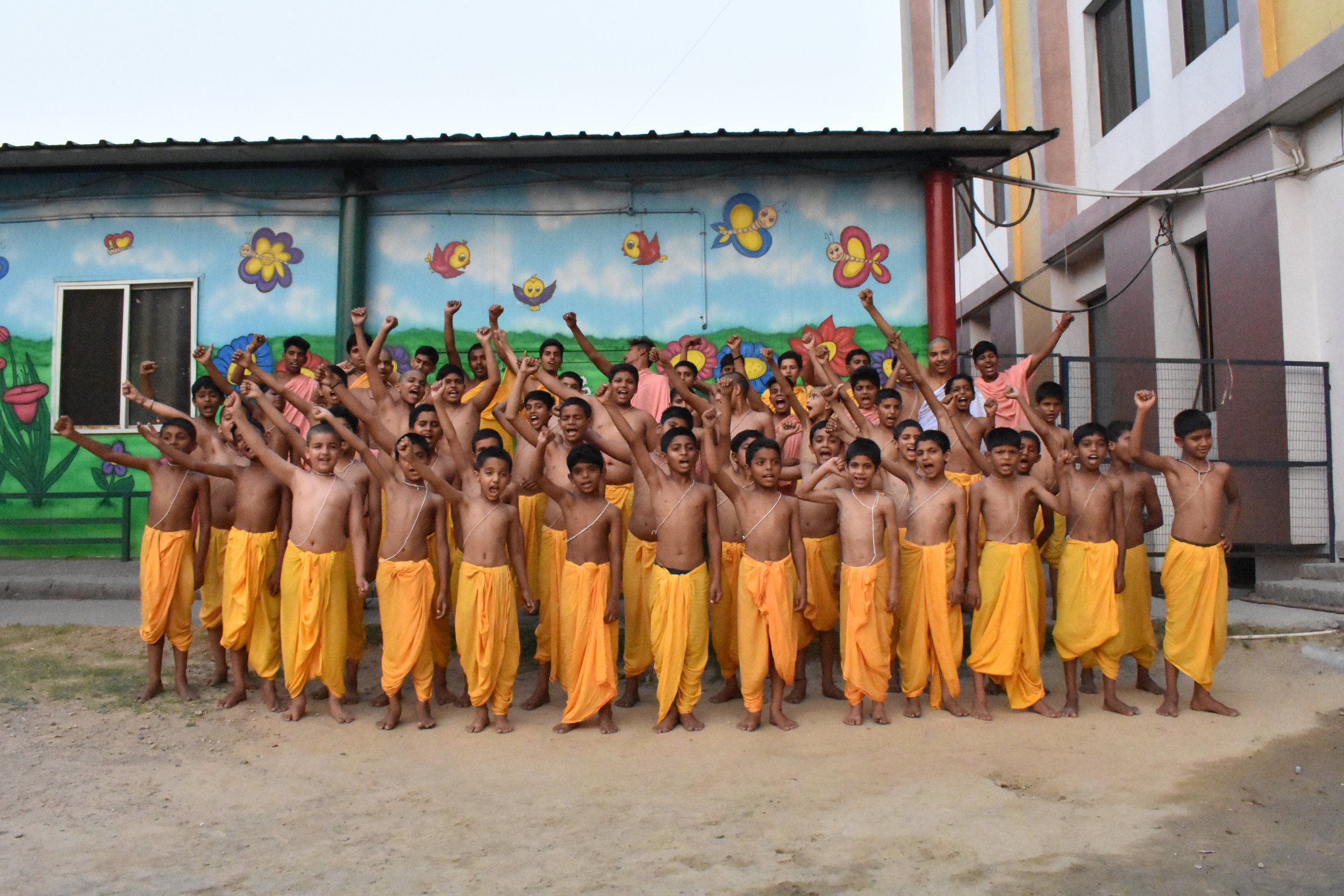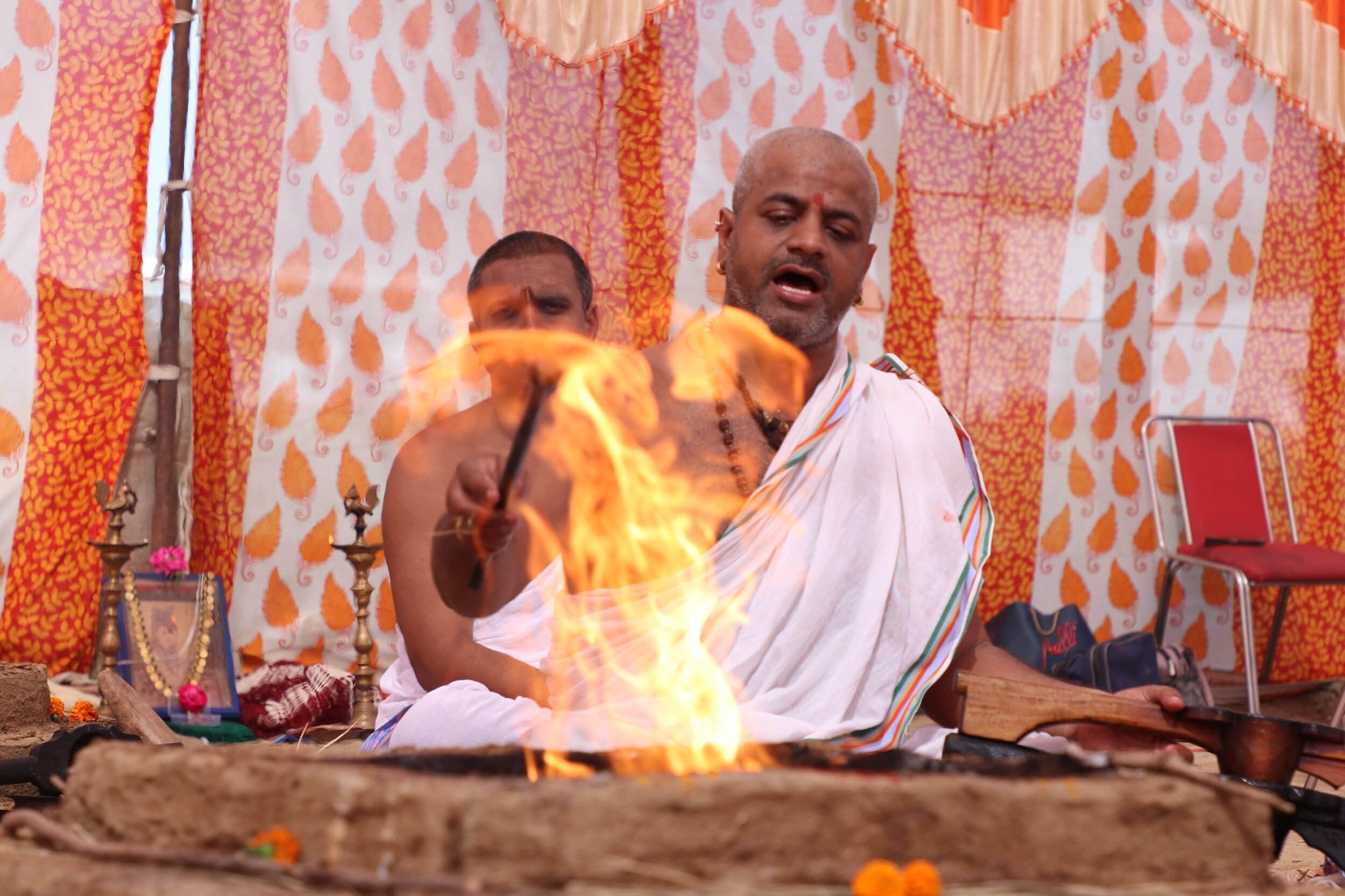
Mission
Vaidika Bharata aims to revive the vaidika traditions, multi-millennial continuum of which had been interrupted by relatively recent adverse periods. Vaidika Bharata aims to revive the paused traditions of the vaidika people by researching and restarting the practices of vaidika shakha-s as philosophical - intellectual – ritualistic - social whole."
Goals
To re-establish the ancient system of education and knowledge which is reflected in the studies of ĀrshaGrantha, so that the graduates from our Paathshālaa are expert in Vedāngaas.
Promotion of Sanskrit language, Vaidika Principles, Vaidika Education & Vaidika Lifestyle.
To motivate people to uphold the Vaidika traditions of Sandhyopāsanam, Shrauta Karma, Gopālanam by assisting them in overcoming the challenges they face.
Gosamvardhana and to make Gau an important factor in the economy of the Hindu society.
To promote traditional Veshabhūshaa, Bhāshā and philosophy.
Protection of natural flora-fauna by promoting plantation of trees and herbs as mentioned in the Vaidika Literature, more so, of the Yajnīya variety.
Promotion of all the Vidyās as referred to in ĀrshaGrantha, viz. Yuddha Vidyā, Krshi Vidyā, Yoga Vidyā, Sangita-Nrtya Vidyā etc. Research on all these and to promote their inculcation in day to day life.
Research on the Angā-Upaangā/allied Granthās of Veda, their publication & creation of new Granthās on these topics.
“Vedas are to be lived,
Not merely studied.”
mohit bharadwaj | Founder

History
We begin our tale in 2014, when Mohit, a young engineer working for a multinational IT Corporation in Noida, was scouting the possibility of improving his repertoire of Yajur Veda, when he met Gyanendra Sapkota, a scholar from Nepal, who shared his passion for reviving the Shukla Yajur Veda Shrauta ritual. It was from scholars in Gujarat that the duo learnt of the last two people proficient in chanting the Samhita of the Shaankhaayana Shaakha, thought extinct.
After visiting Banswada in November 2014, they were joined in their quest by Abhijeet Dinkar Savale of Tryambakeshwar, a young man in his 20s, who had completed studies in the Shukla Yajur Veda and who had learnt Vyakarana (grammar) from Shri Gyanendra Sapkota, while Gyanendra was teaching in Varanasi.
Abhijeet’s hereditary shaakha was the Rig Veda, but he was forced to undergo basic training in the Madhyandina Shaakha of the Shukla Yajur Veda instead. Despite his family’s straitened circumstances, Abhijeet volunteered to spend years in learning the Rig Veda, in order to carry forward the legacy bequeathed to him.
It is but a manifestation of the eternal nature of Sanatana Dharma that three people, a Maharashtrian Madhva, an engineer from Mathura and a Sanskrit Scholar from Nepal, were brought together on this quest to revive a millennia-old tradition, nearly extinct for several centuries.
It was during their second visit that the two exponents, Shri Indrashankar Jha and Shri Harshad Nagar, let it be known that they had handwritten manuscripts in their possession.
After Abhijeet had committed to learning the Shaakha, the three men started going through the manuscripts that were there.
Nothing had quite prepared them for what lay ahead.
Inside a secret treasure cave
What would greet them but a horde of manuscripts from centuries past. Over time, they found that the entire lost Shaankhayana Shaakha was there – Samhita, Brahmana, Aranyaka and Upanishad. To their wonderment, the manuscripts were from a wide range of periods. The earliest was a manuscript of the Shaankhaayana Brahmana that declared itself to have been scribed in Vikrama Samvat 1525, or 1468 CE. To put that in perspective, the earliest Rig Veda manuscript found thus far is from 1464 CE, now preserved at the Bhandarkar Oriental Research Institute, Pune.
From this period until the early part of the 20th Century, there were manuscripts in all centuries, with hardly any gaps beyond a couple of decades.
In this small town, a dedicated group of scholars had preserved and transcribed their knowledge continuously, from before the advent of the Mughals, through the worst depredations of British rule and beyond the rule of Queen Victoria.
And the range of these manuscripts is equally humbling. Besides the entire Shaankhayana Shakha, there were manuscripts of the Shaankhaayana Sutras for performance of Grihya and Shrauta rites, This Sutra was accompanied by the Bhashya, a commentary by an unknown scholar Narayana, whose commentary on other Sutras is in Jammu.
Another scholar, possibly local, has written the entire paddhati, or ritual performance manual.
To give the reader an understanding of the significance of this, the Grihya Sutra would merely state that an aajyabhaaga oblation would have to be given to the accompaniment of a specific Rk or hymn from the Rg Veda.
The Bhashya would further elaborate how the oblation is to be given, the specific implement to use and more details on the Rk to pronounce.
The paddhati would elaborate on how the implement is to be cleansed, with what material, if it is to be whisked with the darbha grass, how many times. Essentially, the paddhati is purely for the practitioner, intended as a guide to choreograph every thought and action of each individual involved in the ritual.
Beyond this, there are manuscripts for various Vedangas or limbs of the Veda, for Vyakarana grammar, as well as paddhati manuals for the pronouncement of these Rks in the Ghana format.
There are manuscripts on detailed chanting guides for the Kauthuma Shaakha of the Saama Veda in the Gurjara paddhati.
It is conceivable that with these set of manuscripts, an entire Shaakha, all rituals and rites associated with it can be revived in it’s entirety and in pristine glory, as it was 3500 years ago, at the earliest.
Abhijeet Savale has taken leave of his profession as a purohit (which would give him a decent living) and spent the last 3 years in mastery of the Shaakha from the two Acharyas. He has done this for a meager stipend merely for sustenance and travel expenses. These expenses have been met by private individuals. He completed his full pāryāyańam, or recital, of the entire shaakha in June 2018.
The Road Ahead
With support from sponsors, scanners have been purchased and the work of digitization and preservation of the manuscripts is continuing in full earnest.
In addition, Vaidika Bharata Trust has started a vedapāthashāla near Delhi, where students are taught the Rig Veda, the Shukla Yajur Veda, and together, the two conduct the Shrauta rites of yore.
In addition, Vaidika Bharata Global Foundation was setup to promote Vaidika knowledge outside the borders of Bharat, to enable diaspora Hindus maintain the continuity of Vaidika traditions.
Ready to help?
Volunteer
—
Donate

